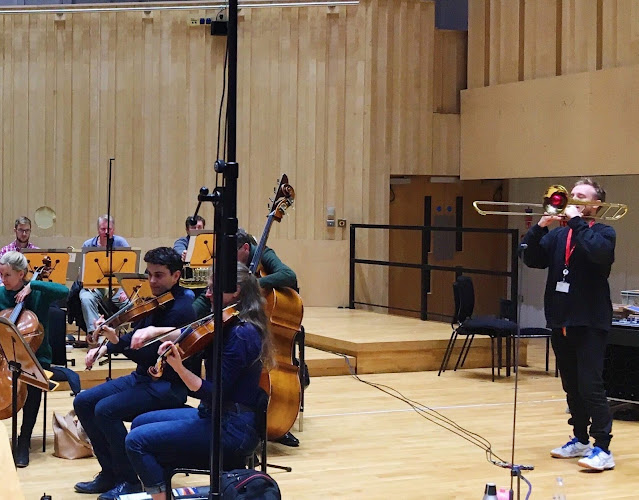 |
| Alex Paxton (Photo Peter Tainsh) |
Alex Paxton has been nominated for three works in two categories in this year's Ivors Composer Awards, he is also a first time nominee. For the second in my series of interviews with composers nominated in this year's awards, I recently chatted to Alex about his three works, Bye and Corncrack Dreams in the Jazz Composition category, and Sometimes Voices in the Small Chamber Composition category. Bye, for small jazz ensemble and improvisor, premiered on 5 November 2020 at Milton Court with the Guildhall Jazz Orchestra directed by Scott Stroman [live stream, and see the review in London Jazz News). Corncrack Dreams for trombone, keyboard and drums was commissioned by Nevis Ensemble and North Uist Distillery and premiered on a Nonclassical release which came out in February, I hope this finds you well in these strange times, vol. 3. Sometimes Voices for keyboard and drums was commissioned by Hyper Duo and premiered by them on 4 June 2020 as part of a streamed concert.
Alex is both a composer and an improvising trombonist, writing music that is stylistically pluralist and informed by his life as a jazz musician & improvisor. Whilst his work crossed the boundaries between jazz and classical, he tends to write the music he wants to write, though he is conscious of the musicians that he might be writing for. And in our chat, he distinguished between three distinct groups of musicians, classical musicians such as orchestras like the London Symphony Orchestra, musicians who are very much engaged with contemporary music, and groove musicians, those who have an important intelligence about them in groove music. When Alex writes a part for an improvisor, he is writing either for himself or for someone who has a voice.
When composing it is more natural for him to write the dots, and he admits that as a composer he wants to make all the decisions. He describes improvisation as 'quick composing', whilst composing is slow improvisation with editing. He wants to make the creative decisions when he writes something out so that he can make the most magic of something possible. When writing for an improvisor he leaves a bubble for another voice, often himself but his pieces work with another voice too. But he is not after a free for all, he is interested in a certain set of energies that improvisors would bring to a work.
 |
| Alex Paxton |
When one of his works with improvisation is taken on by someone other than himself, Alex is excited about someone else's interpretation. There is no wrong way, and it is exciting to have a different type of personality, and frankly, another improvisor is no more worrying than anything else; it is the same for all composers, you are always concerned about the music.
I asked Alex to introduce each of his nominated pieces, and with each work, it became apparent quite how multi-layered (or perhaps multi-tracked) his ideas were, with different elements overlaid and interacting, from pure melody to dirt and noise. And, as anyone who has read one of his evocative programme notes can testify, his descriptions of his pieces often involve remarkable concatenations of striking and contrasting phrases [there is a fine sample describing Dream Musics on his website] .
Alex describes Bye as something of an anomaly in his work; his music is usually quite busy whereas the notation for Bye is somewhat the opposite. But he has sketches for a few more pieces in this vein. The idea came to him in a moment, it is very like a chorale, and he then wrote it over the course of a week. He sees Bye as exploring an important side to his musicianship, one that is not as obvious in his other writing. There is lots of space for the improvising solo, and he feels that it is definitely a pleasing thing to play over. He often sees improvising as being like a big picture, such as one by Hieronymous Bosch, and the improvisor is stepping into the picture.
 |
| Alex Paxton recording with the Royal Scottish National Orchestra |
Corncrack Dreams is one of Alex's recent works exploring what he thinks of as groove music. This style has always been important to him, but until recently he had not explored it properly. And when describing groove music he references the American pianist, composer, organist and bandleader Carla Bley and American jazz double bassist, pianist, composer and bandleader Charles Mingus (1922-1976). In fact, Alex is currently working on a new album which will be jazz-ish groove music for trio. Corncrack Dreams is his first work in this vein, it is also a piece that he began by exploring writing bits of notation for himself to play, to explore something wholly part of his trombone technique (which is that of a jazz trombonist).
Other influences on Corncrack Dreams are the American composers Anthony Braxton and George Lewis from the AACM (Association for the Advancement of Creative Musician). George Lewis recently re-released an album last year, Rainbow Family on Carrier Records, which was originally created in the 1980s at IRCAM in Paris. Both composers have a big presence in Corncrack Dreams. The work started improvisations created in lockdown with a drummer, which were multi-tracked and then Alex chopped them up. Corncrack Dreams was commissioned by the Nevis Ensemble, part of its Lochan Sketches which are short solo works for specific members of the orchestra, where the composer is paired with individuals from across Scotland to take inspiration from the country’s coasts and waters.
For Corncrack Dreams the co-commissioner was the North Uist Distillery, based in the Hebridean island of North Uist where the corncrake lives. The bird evidently makes a rather grating noise, and Alex discovered a recording of lots of them and found the rhythms in the recording had a weird relationship to swing music, reminding him of what he refers to as 'juicy swings from oral music'. So for Corncrack Dreams he used this swing as the groove for the piece and wrote over the top of it. He used the synth that featured on his disc Music for Bosch People [on Birmingham Record Company, see my review], but added other high treble sounds. And he has a small tenor trombone from the 1900s, essentially a sackbut, and he loves this. It makes a really metallic, gristly sound and the trombone part in Corncrack Dreams was very much exploring that.
 |
| Alex Paxton's image create to accompany Sometimes Voices |
Sometimes Voices was a commission from Hyper Duo, which is a contemporary classical drum and keyboard duo. He regards the duo as amazing musicians, and whilst everything is notated, it is a piece of groove music (to date, Alex's only piece of groove music that is fully notated). The work uses two keyboards, one a synth and the other playing samples but the performers also play duck calls and kazoos. The piece is built around a synth which Alex describes as 'really dirty, mono, plastic bag, vacuum cleaner' and he liked the idea that the main keyboard is mono. Like much of his output, the piece is based on contrasts. Alex likes the interaction between song and melody, with noise and dirt. And he talks about all of life encapsulated in a melody but interacting with these really dirty sounds and electronic manipulation. So for Sometimes Voices, the mono synth could sing the blues but had a lineage that included modernism and noise. In the work he was also totally obsessed with the idea of a keyboard playing samples, speeches, anything could come out, and he had a set of patches that followed through with this, and in fact the name of the piece came afterwards.
During lockdown, he watched a lot of Studio Ghibli films; he enjoyed the sound design of the films and this had a bit impact on him. One film, in particular, The Wind Rises, about the man who designed the World War Two fighter planes used by the Japanese, had a very distinctive sound design so that the distinctive sound of the aeroplane engines was mixed with voices, whilst the sound of bombs dropping was mixed with groaning. And he found these ideas in other films from the studio, and the steam-punk, engine mix found its way into Sometimes Voices along with childlike farty sounds, the Teletubbies and even erotic sounds. And here we return to the idea of the melodic side of the synth mixed with the noisy side so that the voice comes out of the dirty noise sounds.
 |
| Alex Paxton's image create to accompany Corncrack Dreams |
Alex is interested in art, though he was not good at it at school. But he finds visual images help him clarify abstract feelings; when he is halfway through a piece, he thinks about a piece of art and it clarifies things, but though he makes reference to visual images (notably his album Music for Bosch People) his music not describing anything. And with Music for Bosch People, the name came last. Also, when a musical parallel is not clear, he finds art helpful and he loves outsider art, art that is not attached to a particular style and is so explicit in how pleasurable it was for the artist to do. And he wants to make music that is just as enjoyable to write.
He has always composed. He was privileged that they had a piano in the house; it was always there and he always made creative music on it. And there was something about the immediacy of being creative with a trombone that appealed, there was not much time till the noise came out. He feels very lucky that when he was around 15 or 16, he found an education pathway for jazz trombone thanks to youth jazz orchestras and the National Youth Jazz Collective. He had never heard any contemporary music until he came to the Royal Academy of Music (RAM) as a jazz trombonist, thanks to that education pathway. He spent two years studying jazz trombone at the RAM, but he became so excited by the idea of composition that he re-auditioned as a composer and did three more years for the undergraduate composition course. At first, he gave up the trombone so that he could devote all his time to writing. He comments that for the trombone, you need to be able to put in the performance time. Then after around four years, he returned to the trombone and at first simply concentrated on what he was good at, but he also used composer to get over any difficulties. Now he finds trombone playing addictive and takes all aspects seriously, but his raison d'etre is to create an improvising voice.
As an improvising musician, you need to practice the musical language for a long time, before improvising, this means that he covers a small amount of musical language more deeply. And he loves the contrast between this and his compositional voice writing lots of notes and he describes these as two different parts of his every day. Also, the trombone is a wonderful way of communicating with people, and he quotes the American composer, conductor and saxophone player John Zorn as saying that the function of the saxophone was to allow him to communicate with all these exciting musicians. Alex feels similar about his trombone, adding that playing it makes him musically enriched.
Coming up, he is writing a piece for the London Sinfonietta which will be premiered at the Queen Elizabeth Hall on 31 March 2022 as part of Tapestries, a concert which pairs Alex's new work with one by his hero George Lewis. Alex will be playing with the ensemble as an improvising soloist and he will be joined by jazz drummer Martin France, so the work will be quite groove based. But Alex has never before done a groove-based work on such a large timescale and he is very excited. The work will also include a children's choir. He has written a lot of music for children, but this is not an education project, though the music will be sung by real children from ordinary schools. He likes creating tapestries, and he wanted to represent the musical relationships that he has made with children. Writing for children is an important part of his work, and influences how he write for adults. He has already done a workshop with children and created a set of samples from these.
 |
| Alex Paxton performing with Ensemble Modern (Photo Walter Vorjohann) |
He has two albums that are already finished. The first is Happy Music for Orchestra, which will be all music written for classical musicians including Bye. The other is I Lollipop which will include a piece he wrote for Ensemble Modern plus Corncrack Dreams and Sometimes Voices. He is also busy writing a piece for himself and members of the Philharmonia, and another for the LSO Panufnik Composers Scheme. And he wants to finish the jazz album, which he is recording with pianist Elliot Galvin and Jay Davies. Not to forget a piece for pianist Zubin Kanga.
This latter finds Alex very excited as he feels Kanga is open to new sound-worlds. Alex listens to a lot of new music and gets excited by different musics and how these all interact. So, it interests him the way electronic music expresses itself in his orchestral music when there is no electronic instrument, and similarly when writing groove music for classical musicians.
Alex Paxton on disc:
- Music for Bosch People - Birmingham Record Company [Amazon]
- Corncrack Dreams on I hope this finds you well in strange times, Vol 3 - Nonclassical [Amazon]
Alex Paxton on Spotify and YouTube:
- London Symphony Orchestra in Dadd's Fairies [YouTube]
- Hyper Duo in Sometimes Voices [Spotify]
- Non-Classical Corn-Crack Dreams [Spotify]
- Tabea Debus in TellSong [Spotify]
Never miss out on future posts by following us
The blog is free, but I'd be delighted if you were to show your appreciation by buying me a coffee.
Elsewhere on this blog
- From a puppet 'Liederspiel' to men behaving badly: Thomas Guthrie and Barokksolistene at Temple Music - concert review
- From youthful jeux d'esprit to late, late masterworks: Saint-Saens' chamber music with winds is well-worth exploring - record review
- A disc to make us re-consider: Peter Warlock Songbook from Luci Briginshaw and Eleanor Meynell - record review
- From The Poppy to Hit Her on the Bum: Ensemble Hesperi's debut disc, Full of the Highland Humours - record review
- Inspired by the work of sculptor Naum Gabo, I chat to Alex Groves about his latest music, as well as creating pieces inspired by Barbara Hepworth, and the importance of his concert series, Solo - interview
- Intimate and intense: Mahler with just voice and piano, Alice Coote, Stuart Jackson and Julius Drake at Temple Song - concert review
- Recycle, re-use, re-think: Dai Fujikura's latest disc Glorious Clouds - record review
- Walton's comic masterpiece, The Bear, in a delightful new film from Opera Holland Park - opera review
- No interpretation is the correct one; at the same time, with the resources that we have in front of us, it would seem churlish not to make the effort to try to understand what the composer meant - guest posting
- From warm good humour to gripping drama: Haydn and Bartok from London Philharmonic Orchestra and Edward Gardner - opera review
- Finding her own way: I chat to cellist Clare O'Connell about her innovative concert series in Berkhamsted, Behind the Mirror - interview
- From Coldplay & Daft Punk to Lord of the Dance & Mass Participation: Remix, Music for Youth Prom - concert review
- Home



%20and%20kids.jpg)
.webp)





.jpg)
No comments:
Post a Comment